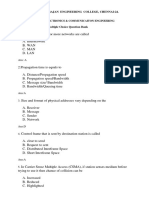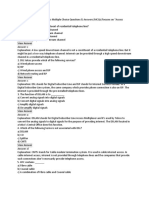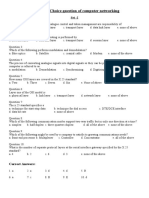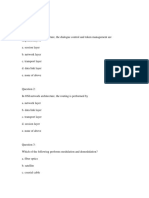Chapter 9: Flow and Error Control
Uploaded by
saffarazadChapter 9: Flow and Error Control
Uploaded by
saffarazadChapter 9 : Flow and Error Control
1. SONET is a standard for _______ networks. a. Twisted-pair cable b. Fiber-optic cable c. Coaxial cable d. Ethernet The correct answer is b 2. _______ limit the bandwidth of the local loop to 4 KHz. a. Fiber nodes b. Repeaters c. Filters d. Hubs The correct answer is c 3. The actual bit rate of ADSL downstream data is _______. a. 6 to 30 Kbps b. 64 Kbps to 1 Mbps c. 500 Kbps to 8 Mbps d. 31 Kbps to 255 Mbps The correct answer is c 4. _______ is a device at the telephone company site that can packetize data to be sent to the ISP server. a. A filter b. A splitter c. A DSLAM d. An ADSL modem The correct answer is c 5. The standard for data transmission over an HFC network is called _______. a. DOCSIS b. CMTS c. MCNS d. ADSL The correct answer is a 6. DMT is a modulation technique that combines elements of _______ and _______. a. FDM; TDM b. QDM; QAM c. PSK; FSK d. FDM; QAM The correct answer is d 7. The _______ is an HFC network device installed inside the distribution hub that receives
data from the Internet and passes them to the combiner. a. DOCSIS b. MCNS c. CM d. CMTS The correct answer is d 8. HDSL encodes data using _______. a. 6B/8T b. 4B/5B c. 2B1Q d. 1B2Q The correct answer is c Your answer is a 9. _______ encoded signal is more susceptible to attenuation than _______ encoded signal. a. An AMI; a 2B1Q b. An AMI; a 2B2Q c. A 2B1Q; an AMI d. None of the above The correct answer is a 10. Another name for the cable TV office is the _______. a. Fiber node b. Combiner c. Head end d. Splitter The correct answer is c 11. A traditional cable TV network transmits signals ______. a. Upstream and downstream b. Upstream c. Downstream d. None of the above The correct answer is c 12. _______ was designed as an alternative to the T-1 line. a. VDSL b. SDSL c. HDSL d. ADSL The correct answer is c 13. The synchronous payload envelope of an STS-1 frame contains _______. a. Pointers b. User data
c. Overhead d. (b) and (c) The correct answer is d 14. _______ has a higher transmission rate in the downstream direction than in the upstream direction. a. VDSL b. ADSL c. SDSL d. (a) and (b) The correct answer is d 15. An HFC network uses _______ as the medium from the switch to the fiber node. a. UTP b. STP c. Optical fiber d. Coaxial cable The correct answer is c 16. In an HFC network, the distribution hub handles the _______ of signals. a. Modulation b. Distribution c. Splitting d. (a) and (b) The correct answer is d 17. A TV channel in an HFC network needs a _______-MHz bandwidth. a. 369 b. 6 c. 100 d. 250 The correct answer is b 18. _______ data go from the subscriber to the Internet. a. Downstream b. Upstream c. Midstream d. None of the above The correct answer is b 19. In an HFC network, the upstream data are modulated using the _______ modulation technique. a. PCM b. QAM c. QPSK d. ASK
The correct answer is b 20. _______ is suitable for businesses that require comparable upstream and downstream data rates. a. SDSL b. VDSL c. ADSL d. (a) and (b) The correct answer is a 21. SONET is an acronym for _______ Network. a. Standard Optical b. Symmetric Open c. Synchronous Optical d. Standard Open The correct answer is c 22. The largest portion of the bandwidth for ADSL carries _______. a. Voice communication b. Downstream data c. Upstream data d. Control data The correct answer is b 23. In a SONET system, _______ can remove signals from a path. a. An add/drop multiplexer b. A repeater c. An STS multiplier d. A regenerator The correct answer is a
You might also like
- Asus Rog Zephyrus G15 GA502IU Gaming BoardviewNo ratings yetAsus Rog Zephyrus G15 GA502IU Gaming Boardview2 pages
- Dell Inspiron 15 5567 BAL20 LA-D801P Rev 1.0 (A00) SchematicsNo ratings yetDell Inspiron 15 5567 BAL20 LA-D801P Rev 1.0 (A00) Schematics61 pages
- This Set of Computer Networks Multiple Choice Questions100% (2)This Set of Computer Networks Multiple Choice Questions83 pages
- Forouzan MCQ in Telephone and Cable NetworksNo ratings yetForouzan MCQ in Telephone and Cable Networks13 pages
- Sana'a University Faculty of Eng. Final Term Exam Communication Networks Dr. Ali Manea Alsaih June 2007No ratings yetSana'a University Faculty of Eng. Final Term Exam Communication Networks Dr. Ali Manea Alsaih June 20076 pages
- Data And Computer Communications 10th Edition Stallings Test Bank pdf download100% (2)Data And Computer Communications 10th Edition Stallings Test Bank pdf download46 pages
- Networking C-CAT Ques Part-1: Newtworking Objective Type QuestionsNo ratings yetNetworking C-CAT Ques Part-1: Newtworking Objective Type Questions48 pages
- CH 9 Telephone and Cable Networks For Data Transmission Multiple Choice Questions and Answers MCQ PDFNo ratings yetCH 9 Telephone and Cable Networks For Data Transmission Multiple Choice Questions and Answers MCQ PDF10 pages
- Data And Computer Communications 10th Edition Stallings Test Bank instant download100% (1)Data And Computer Communications 10th Edition Stallings Test Bank instant download41 pages
- bcs-304-data-communication-and-networking-mcqsNo ratings yetbcs-304-data-communication-and-networking-mcqs13 pages
- Get Data And Computer Communications 10th Edition Stallings Test Bank free all chapters100% (18)Get Data And Computer Communications 10th Edition Stallings Test Bank free all chapters34 pages
- Data And Computer Communications 10th Edition Stallings Test Bank all chapter instant download100% (3)Data And Computer Communications 10th Edition Stallings Test Bank all chapter instant download43 pages
- Data And Computer Communications 10th Edition Stallings Test Bank all chapter instant download100% (10)Data And Computer Communications 10th Edition Stallings Test Bank all chapter instant download33 pages
- Electronic Communication Principles by Blake Chapter 12 AnswersNo ratings yetElectronic Communication Principles by Blake Chapter 12 Answers8 pages
- Data And Computer Communications 10th Edition Stallings Test Bank pdf download100% (1)Data And Computer Communications 10th Edition Stallings Test Bank pdf download38 pages
- Complete Answer Guide for Data And Computer Communications 10th Edition Stallings Test Bank100% (2)Complete Answer Guide for Data And Computer Communications 10th Edition Stallings Test Bank43 pages
- Multiple Choice Question of Computer Networking100% (3)Multiple Choice Question of Computer Networking13 pages
- Data And Computer Communications 10th Edition Stallings Test Bankinstant download100% (2)Data And Computer Communications 10th Edition Stallings Test Bankinstant download41 pages
- Communications Engineering Part 12 Data Communications Multiple Choice: Encircle The Letter That Corresponds To Your AnswerNo ratings yetCommunications Engineering Part 12 Data Communications Multiple Choice: Encircle The Letter That Corresponds To Your Answer10 pages
- Cs601 Finalterm Important Mcqs Muhammad Faisal Dar Mit 4Th SemesterNo ratings yetCs601 Finalterm Important Mcqs Muhammad Faisal Dar Mit 4Th Semester25 pages
- The Transparency Mechanism Used With SDLC Is CalledNo ratings yetThe Transparency Mechanism Used With SDLC Is Called30 pages
- CS601 Solved MCQs Compiled Mid-Giga-File With 300-PagesNo ratings yetCS601 Solved MCQs Compiled Mid-Giga-File With 300-Pages479 pages
- CISSP Exam Prep Questions, Answers & Explanations: 1500+ CISSP Practice Questions with SolutionsFrom EverandCISSP Exam Prep Questions, Answers & Explanations: 1500+ CISSP Practice Questions with Solutions3/5 (7)
- DAC-RS232: Rs232 Interface For Digital Axle CounterNo ratings yetDAC-RS232: Rs232 Interface For Digital Axle Counter2 pages
- CTS CVT-3002-PLUS HW-Ver.-B1 UG V2.1 20220225No ratings yetCTS CVT-3002-PLUS HW-Ver.-B1 UG V2.1 202202252 pages
- Cable TV Networks and FTTX: U.K.P. Mihiranga (Mba in Mot, B.Sc. Eng. (Hons), Pmp-Pmi (Usa), Amiesl)No ratings yetCable TV Networks and FTTX: U.K.P. Mihiranga (Mba in Mot, B.Sc. Eng. (Hons), Pmp-Pmi (Usa), Amiesl)24 pages
- Low Cost Displayport™ To Lvds Converter: FeaturesNo ratings yetLow Cost Displayport™ To Lvds Converter: Features2 pages
- Dell Inspiron 15 5567 BAL20 LA-D801P Rev 1.0 (A00) SchematicsDell Inspiron 15 5567 BAL20 LA-D801P Rev 1.0 (A00) Schematics
- This Set of Computer Networks Multiple Choice QuestionsThis Set of Computer Networks Multiple Choice Questions
- Indoor Radio Planning: A Practical Guide for 2G, 3G and 4GFrom EverandIndoor Radio Planning: A Practical Guide for 2G, 3G and 4G
- Sana'a University Faculty of Eng. Final Term Exam Communication Networks Dr. Ali Manea Alsaih June 2007Sana'a University Faculty of Eng. Final Term Exam Communication Networks Dr. Ali Manea Alsaih June 2007
- Data And Computer Communications 10th Edition Stallings Test Bank pdf downloadData And Computer Communications 10th Edition Stallings Test Bank pdf download
- Networking C-CAT Ques Part-1: Newtworking Objective Type QuestionsNetworking C-CAT Ques Part-1: Newtworking Objective Type Questions
- CH 9 Telephone and Cable Networks For Data Transmission Multiple Choice Questions and Answers MCQ PDFCH 9 Telephone and Cable Networks For Data Transmission Multiple Choice Questions and Answers MCQ PDF
- Data And Computer Communications 10th Edition Stallings Test Bank instant downloadData And Computer Communications 10th Edition Stallings Test Bank instant download
- Get Data And Computer Communications 10th Edition Stallings Test Bank free all chaptersGet Data And Computer Communications 10th Edition Stallings Test Bank free all chapters
- Data And Computer Communications 10th Edition Stallings Test Bank all chapter instant downloadData And Computer Communications 10th Edition Stallings Test Bank all chapter instant download
- Data And Computer Communications 10th Edition Stallings Test Bank all chapter instant downloadData And Computer Communications 10th Edition Stallings Test Bank all chapter instant download
- Electronic Communication Principles by Blake Chapter 12 AnswersElectronic Communication Principles by Blake Chapter 12 Answers
- Data And Computer Communications 10th Edition Stallings Test Bank pdf downloadData And Computer Communications 10th Edition Stallings Test Bank pdf download
- Complete Answer Guide for Data And Computer Communications 10th Edition Stallings Test BankComplete Answer Guide for Data And Computer Communications 10th Edition Stallings Test Bank
- Data And Computer Communications 10th Edition Stallings Test Bankinstant downloadData And Computer Communications 10th Edition Stallings Test Bankinstant download
- Communications Engineering Part 12 Data Communications Multiple Choice: Encircle The Letter That Corresponds To Your AnswerCommunications Engineering Part 12 Data Communications Multiple Choice: Encircle The Letter That Corresponds To Your Answer
- Cs601 Finalterm Important Mcqs Muhammad Faisal Dar Mit 4Th SemesterCs601 Finalterm Important Mcqs Muhammad Faisal Dar Mit 4Th Semester
- The Transparency Mechanism Used With SDLC Is CalledThe Transparency Mechanism Used With SDLC Is Called
- CS601 Solved MCQs Compiled Mid-Giga-File With 300-PagesCS601 Solved MCQs Compiled Mid-Giga-File With 300-Pages
- CompTIA Network+ N10-005 Exam Questions 600+From EverandCompTIA Network+ N10-005 Exam Questions 600+
- CISSP Exam Prep Questions, Answers & Explanations: 1500+ CISSP Practice Questions with SolutionsFrom EverandCISSP Exam Prep Questions, Answers & Explanations: 1500+ CISSP Practice Questions with Solutions
- DAC-RS232: Rs232 Interface For Digital Axle CounterDAC-RS232: Rs232 Interface For Digital Axle Counter
- Cable TV Networks and FTTX: U.K.P. Mihiranga (Mba in Mot, B.Sc. Eng. (Hons), Pmp-Pmi (Usa), Amiesl)Cable TV Networks and FTTX: U.K.P. Mihiranga (Mba in Mot, B.Sc. Eng. (Hons), Pmp-Pmi (Usa), Amiesl)

























































































